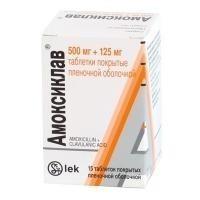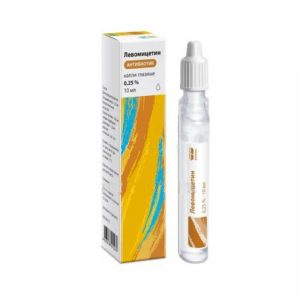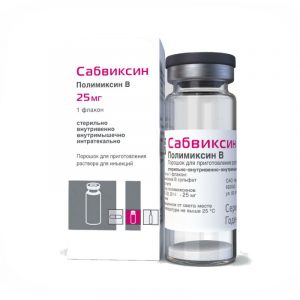Description
Release form
Film-coated tablets
Packaging
15 pcs
Pharmacological action
Amoxiclav – a broad-spectrum antibiotic contains semisynthetic penicillin amoxicillin and a b-lactamase clavulanic acid inhibitor. Clavulanic acid inhibits most clinically significant b-lactamases (types 2, 3, 4 and 5 – according to the classification of Richmond Sykes) produced by Staphylococcus spp., Escherichia coli, Proteus mirabilis, Haemophilus influenzae, Moraxella catarrhalis, Bacteroides spp. Inactive against type 1 b-lactamases produced by Enterobacter spp., Morganella morganii, Pseudomonas aeruginosa, Serratia spp., Acinetobacter spp.
This combination provides high bactericidal activity of Amoxiclav (including against strains of microorganisms resistant to amoxicillin). Clavulanic acid, having a higher affinity for b-lactamase than amoxicillin, forms a stable deactivated complex with the enzyme, preventing the enzymatic degradation of amoxicillin under the action of b-lactamases.
Thus, Amoxiclav acts bactericidal on a wide range of gram-positive and gram-negative bacteria (including strains, which have become resistant to beta-lactam antibiotics due to the production of b-lactamases).
Indications
Treatment of infectious and inflammatory diseases caused by microorganisms sensitive to the drug: – infections of the upper respiratory tract and ENT organs (including acute and chronic sinusitis, acute and chronic otitis media, pharyngeal abscess, tonsillitis, pharyngitis)
– infections of the lower respiratory tract (including acute bronchitis with bacterial superinfection, chronic bronchitis, pneumonia)
– urinary tract infections
– gynecological infections
– infections of the skin and soft tissues
– infections of the bones and joints
– infections of the biliary tract (cholecystitis, cholangitis)
– odontogenic infections.
Contraindications
– cholestatic jaundice or impaired liver function, caused by a history of amoxicillin / clavulanic acid
– hypersensitivity to amoxicillin, clavulanic acid or penicillins.
With caution, the drug should be prescribed for allergic reactions to cephalosporins and pseudomembranous colitis in the anamnesis, liver failure, severe renal impairment.
Due to the fact that in a large number of patients with infectious mononucleosis and lymphocytic leukemia who received ampicillin, the appearance of an erythematous rash was observed, the use of ampicillin antibiotics in such patients is not recommended.
Use during pregnancy and lactation
Amoxicillin and clavulanic acid pass into breast milk in small amounts.
Amoxiclav can be used during pregnancy if the expected benefit to the mother outweighs the potential risk to the fetus.
Special instructions
During the course of treatment, the function of hematopoiesis, liver and kidneys should be monitored.
Patients with severe renal impairment require adequate dosage adjustment or increased dosing intervals.
In order to reduce the risk of adverse reactions from the gastrointestinal tract, the drug should be taken with meals.
When using Amoxiclav, a false-positive reaction is possible when determining the level of glucose in the urine when using Benedict’s reagent or Felling’s solution (enzymatic reactions with glucose oxidase are recommended).
Concurrent administration with disulfiram should be avoided.
Composition
1 tablet (625 mg) contains amoxicillin (as trihydrate) mg and clavulanic acid (as potassium salt) 125 mg
Dosage and administration
Adults and children over 12 years of age (or weighing more than 40 kg) for mild or moderate infections are prescribed 1 tab. 375 mg every 8 hours, in case of severe infection and respiratory tract infections – 1 tab. 625 mg every 8 hours or 1 tab. 1000 mg every 12 hours.
The drug in the form of coated tablets is not prescribed for children under 12 years of age (weighing less than 40 kg).
The maximum daily dose of clavulanic acid for adults is 600 mg, for children – 10 mg / kg body weight.
The maximum daily dose of amoxicillin is 6 g for adults and 45 mg / kg of body weight for children.
The course of treatment is 5-14 days. The duration of the course of treatment is determined by the attending physician. Treatment should not last more than 14 days without a second medical examination.
For odontogenic infections, 1 tab. 375 mg every 8 hours for 5 days.
Side effects of the
From the digestive system: possible loss of appetite, nausea, vomiting, diarrhea rarely – transient increase in the activity of liver enzymes (ALT, AST), impaired liver function in isolated cases – cholestatic jaundice, hepatitis, pseudomembranous colitis.
Allergic reactions: erythematous rash, pruritus, urticaria, rarely – multiforme exudative erythema, angioedema, anaphylactic shock in isolated cases – exfoliative dermatitis, Stevens-Johnson syndrome.
Other: rarely – development of superinfection, candidiasis.
Drug interaction
With the simultaneous use of Amoxiclav and indirect anticoagulants, an increase in prothrombin time is noted. Therefore, this combination is prescribed with caution.
With the simultaneous use of Amoxiclav with allopurinol, the risk of developing side effects such as exanthema increases.
With the simultaneous use of Amoxiclav enhances the toxicity of methotrexate.
The combination of amoxicillin with rifampicin is antagonistic (there is a mutual weakening of the antibacterial effect).
Amoxiclav should not be used simultaneously with bacteriostatic antibiotics (macrolides, tetracyclines), sulfonamides due to a possible decrease in the effectiveness of Amoxiclav.
With the simultaneous use of Amoxiclav reduces the effectiveness of oral contraceptives.
Storage conditions
The product should be stored in a dry, out of the reach of children at a temperature not exceeding 25 ° C.
Expiration
2 years.
drugstore conditions
drugstore
lekarstvennaja form
tablets
Indications
Indications
Diaper rash, psoriasis, dermatitis, dermatosis, allergy, eczema Azania
osteomyelitis, otitis media, sinusitis, pneumonia, periodontitis, urinary tract infections, bronchitis, Angina




